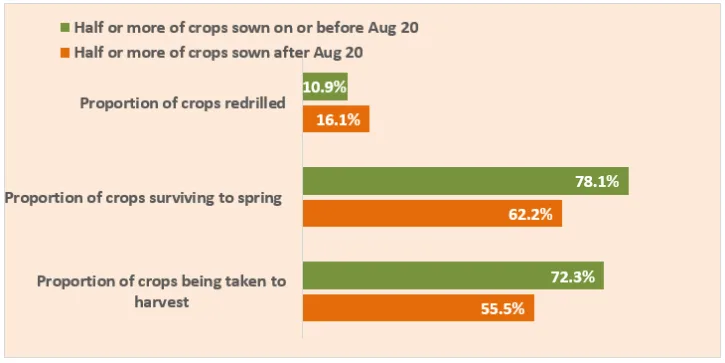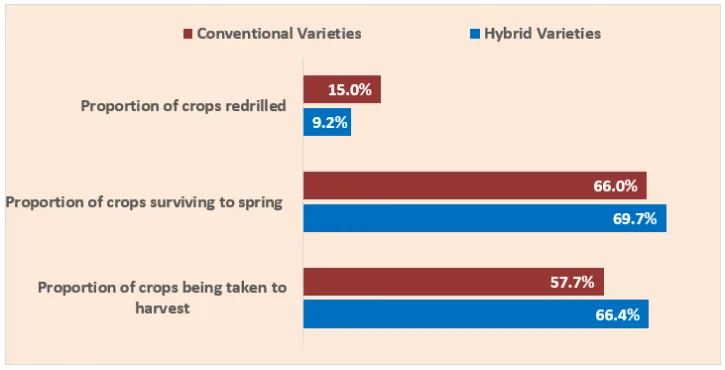
Drilling the right type of OSR under the right conditions can make all the difference to crop success even in a very challenging cabbage stem flea beetle season, reveals the first-ever national farm CSFB management study conducted this spring.
Author
| 24th June 2020Tags
National Farm Study Highlights CSFB Management Opportunities
Drilling the right type of OSR under the right conditions can make all the difference to crop success even in a very challenging cabbage stem flea beetle season, reveals the first-ever national farm CSFB management study conducted this spring.
Involving more than 220 growers planting over 24,000 ha of OSR across the main arable areas of the country last autumn, the Bayer study reveals that an average of only 61% of their crops are being taken through to harvest. Overall, around 14% had to be re-drilled, 32% were lost over the autumn and winter and a further 7% abandoned by early April.
Re-drilling levels were, however, reduced to just under 4% on average, with crop survival to the spring increased to almost 81% and over 78% taken to harvest where the bulk of the OSR was sown on or before Aug 20 and the main variety was a hybrid.
In complete contrast, 21% of sowings on or after September 1 based on conventional varieties had to be re-drilled, only 52% making it through to the spring and just 48% to harvest.
“These are the extremes and only the harvest will tell the full story,” accepts Bayer study
co-ordinator, Edward Hagues. “In many cases too, the pressures of last autumn overwhelmed even the most robust flea beetle defences. “Even so, our findings underline the valuable opportunities growers have to combat these pressures with appropriate management.”
Confirming anecdotal reports, the study shows a wide variation in overall crop success across the country; the proportion of crops being taken to harvest varying from an average of just 45% in the East Midlands to 71% in Yorkshire & Humberside. Also noticeably worse hit than average were growers in the South West while those in Eastern England fared relatively better.
“As well as autumn and winter losses, our figures show considerable variation across the country in the proportion of crops lost in the spring – presumably due to larvae,” notes Mr Hagues. “The lowest losses here at just 3% were in Yorkshire & Humberside while, at over 14%, growers in the South East suffered far more.
“This could be linked to South Eastern growers drilling almost 45% of their crops on or before August 20 compared to less than 11% in Yorkshire & Humberside; especially so since higher larval levels were reported in our study the earlier crops were sown.”
Despite this, sowing date was found to have the biggest impact on overall crop success. On average, growers sowing half or more of their OSR up to August 20 are bringing 72% of it through to harvest compared to just under 56% for those sowing the bulk of their crop from August 21 (Figure 1).
Figure 1: Sowing Date & Crop Success

The extent to which this is related to differences in soil moisture as well as pressure from flea beetle is clear from the study. On the one hand, only a third of crops sown on or before August 20 were reported to have suffered from intense or substantial flea beetle pressure at establishment against two thirds of those from later plantings. And, on the other, less than 20% of earlier sown crops were judged to have been sown into low or very low soil moisture levels against almost 50% of later sowings.
“Few, if any, differences were evident between the success of crops established by the most widely-used direct drilling, minimum tillage or subsoiler seeding regimes,” Mr Hagues reveals. “A rather higher proportion of those established with plough-based systems are being taken through to harvest. However, this may owe more to the fact that plough-based systems were employed to establish more of those crops sown earlier than anything else.
“Variety type, though, stood out alongside drilling date as having an association with crop success, regardless of other effects. Overall, fewer hybrid crops had to be re-drilled last autumn than conventionally-bred ones, more survived to the spring and many more are being taken through to harvest (Figure 2). And this despite the fact that a much greater proportion of hybrids than conventionals were sown in the more challenging post-August 20 slots.
Figure 2: Variety Type & Crop Success

“Hybrids proved more successful than conventional varieties in all five sowing periods we recorded,” he adds. “Taken together, growers planting half or more of their crops up to August 20 are bringing just over 6% more of them to harvest if they are hybrids while the advantage more than doubles to almost 13% where the bulk of sowings are later.”
The particular value of hybrids which are fast-developing in the autumn as well as vigorous in their establishment is highlighted in the survey’s detailed examination of the techniques other than sowing date being employed by growers to manage the adult flea beetle threat.
The overwhelming majority of growers employed at least one of 13 main techniques last autumn, the most popular being insecticide spraying; seedbed fertilisation; double rolling; vigorous, fast-developing hybrids; higher seed rates; volunteer OSR trap crops; and, organic manure spreading – all used by more than a third of farms.
Of these, only two widely-used techniques – organic manuring and the use of vigorous, fast-developing hybrids – were associated with a higher proportion of crops than average being taken to harvest this summer (Figure 3). While greater overall crop success was also recorded with companion cropping and the use of deterrent sprays or colourants, the relatively small numbers using these techniques mean these data need to be treated with particular caution.
Figure 3: Adult CSFB Management Techniques & Crop Success

* Limited data – treat with caution
Especially disappointing in their apparent success in adult beetle management were double rolling, leaving long cereal stubbles, using farm saved seed and insecticide spraying (although the latter could be a consequence of the flea beetle pressure that necessitated it).
Increasing the number of insecticide sprays from one to three was clearly associated with a lower percentage of crops needing to be re-drilled and better crop survival both to the spring and to harvest. But even the best performance here was well below average in itsoverall crop success.
Among the two further techniques most widely employed to manage CSFB larvae, the use of varieties with faster or earlier spring development was noticeably more successful than systemic insecticide spraying. Grazing ahead of stem extension also appeared promising in terms of the number of crops taken to harvest but the small numbers using the technique mean these data need treating with caution too.
“The specific ratings growers gave for the establishment, larval level and subsequent recovery of their crops in our study confirmed the relative value of the various management techniques employed,” points out Mr Hagues.
“Establishment scores showed a clear decline with later drilling as did larval levels. Crop recovery in the spring, however, was better from early drilling, almost certainly due to improved initial establishment in more favourable conditions as well as survival over the very wet winter.
“Again with the possible exception of plough-based systems, there were few, if any, detectable differences in establishment, larval level or crop recovery ratings between the different establishment regimes.
“In establishment terms, growers rated conventional and hybrid varieties very similarly. However, larval levels were noticeably lower and crop recovery scores correspondingly higher with hybrids, underlining their particular ability to grow away from problems.
“Although from a relatively small sample size, companion cropping achieved the highest average establishment score of the various management techniques,” he reports.
“Otherwise, few differences were evident between the adult management techniques.
“When it came to larval scores, though, the differences were clear, with vigorous, fast-developing hybrids doing the best and farmed saved seed and higher seed rates the worst.
“While organic manuring only scored averagely in establishment and larval levels, it was up near the top along with vigorous fast developing hybrids and varieties with faster or earlier spring development in terms of spring recovery. Again, crops from farm-saved seed at higher seed rates were at the bottom of the ratings here.”
Other than sowing date, it isn’t surprising then that growers judge the most successful mainstream cabbage stem flea beetle management techniques to be vigorous fast developing hybrids and varieties with faster or earlier spring development (Figure 4).
Figure 4: Perceived Success of Main Adult and Larval Management Techniques

Companion cropping and grazing-off crops before stem extension were also rated relatively highly, although from very small numbers of growers.
Only rated in the middle of the pack – surprisingly given its apparent success – is organic manuring, alongside higher seed rates and farm saved seed which carry rather higher ratings than their performance appears to warrant.
Spraying insecticides and leaving OSR volunteers from previous crops are considered the least effective of the broadly-employed techniques by far – very much in line with their recorded performance.
“Given the intensity of last autumn’s challenge from the combination of flea beetle pressure and dryness, the fact that growers only rated the techniques they consider most successful at around 5.0 on a 0 to 9 scale is not surprising,” says Mr Hagues.
“Earlier drilling stood out as an important key to crop success for most last year. However, its value fundamentally depended on sufficient soil moisture to ensure crops kept growing well enough ahead of the peak of flea beetle migration. So, the key here clearly has to be to sow only when there is sufficient moisture.
“Varieties like DK Exstar, DK Exsteel and DK Exalte carrying both rapid autumn development and vigorous establishment traits look like being especially valuable regardless of sowing date,” he reasons. “After all, the imperative is to get the crop away and, I suspect, the need for autumn growth regulation would be seen as a positive by most these days.
“With growers also find varieties that develop earlier or faster in the spring have a useful edge in managing flea beetle larvae, the earliest spring developers of all – DK Extremus and
DK Expedient – appear to offer particular value wherever larvae have been proving at least as problematic as adult beetles.
“While almost 20% of the growers involved in our study are seriously considering whether to plant OSR again this autumn, the majority are planning to stick with the crop and step-up their efforts to manage CSFB,” concludes Mr Hagues.
“Unsurprisingly, using vigorous, fast-developing varieties tops their list of future management priorities alongside seedbed fertilisation and double rolling. Drilling early (where moisture levels allow) is also being planned by more than a third of growers.
“Despite their well-known canopy management and productivity drawbacks, high seed rates are seen as a valuable strategy too. Thankfully, though, few are looking to combine this with sowing farm saved seed – an approach associated with some of the lowest levels of overall crop success and highest spring losses in our study.”
Welcome to DEKALB
New generations of DEKALB hybrids combine top yield-protecting traits for your unique field.